🎵They Write the Songs, Pt. 2: Barry Manilow Hits as Recorded by the Original Songwriters
While he wrote a lot of songs (usually with a handful of trusted colleagues), he didn't write all his hits! Here are 3 of Barry's biggest smashes as first recorded by the original songwriters!
For Part 2 of “They Write the Songs,” we take a peek at three more songs Barry Manilow chose to cover. The fact that they each became hits of varying chart positions is a tribute to the songwriter, certainly.
But, the original inspiration behind this exercise actually began in the late 1980s, when I made a mix-tape of Barry’s hits that were written (and recorded) by the songwriters themselves.
The point was (and is now) to celebrate the prodigious nature of Manilow’s ability to arrange a song…to take a good, even a great song, and make it radio-ready, and ultimately, a hit! Part 1 (with “Mandy,” “Tryin’ to Get the Feeling Again,” and “I Write the Songs”) can be accessed here:
Back in the Day, “Somewhere in the Night”
One of the first songs composed by Richard Kerr (above) and celebrated lyricist, Will Jennings, as a team (along with their “Looks Like We Made It,” which hit #1 for Barry in 1977), “Somewhere in the Night” appeared on four 1975 album releases, including the You Are a Song album by duo, Batdorf & Rodney, on Arista Records. In fact, it’s likely this is the most-covered song ever tackled by Barry prior to his recording.
Kim Carnes, Helen Reddy (who took her single to #19), and Yvonne Elliman also included the song on their respective ‘75 albums (Spotify song links for each linked to their names). Each are, generally, rather pedestrian (but certainly serviceable) arrangements, despite the fact that each employ a full orchestra and choral singers.
Challenge: Listen to all, and (especially if it’s been a while since you’ve heard Barry’s) see if you can pinpoint elements Barry might have discarded for his cover, and those things he wanted to make sure he included that the others didn’t.
It’s a testament, again, to Barry’s surgical precision in the placement of these various elements that separate other covers from the impressive results he was able to obtain, with the resultant, almost predictable top-of-the-charts outcome for each single.
According to Songfacts, the cover Kerr believes came closest to being the definitive version was Batdorf & Rodney’s (audio-only YouTube video above), which got to #69 on Billboard’s Hot 100 chart in the fall of 1975. B&R were a short-lived folk-rock duo whose album was co-produced by Manilow’s Arista Records chief, Clive Davis.
Assume that there’s a causal relationship between Clive’s involvement with the Batdorf & Rodney cover (his co-production and whatever hand he may have had in its rather sumptuous arrangement, including strings and full choral backgrounds), and the possible likelihood of Manilow using this version as a “template” of sorts for his.
Also assume he wanted to hear all the previous covers by the aforementioned ladies, and more certainly, the songwriter, Kerr’s arrangement, released on Clive’s former employer, Epic/CBS Records in early ‘76:
As Kerr explained on The Paul Leslie Hour in 2022: “I looked at a few of Will’s lyrics - he never had a hit at this stage, he’d just come over from Nashville, himself - and I looked at some of these lyrics and I just thought, ‘This is my sort of lyric. What he writes, it’s from the heart, I can write with this guy,’ and so we decided to sit down and write together.”
On that same trip to L.A. where he first met Jennings [above, a Kilgore, TX native; his East Texas hometown was creatively highlighted recently by fellow Texas writer,
, on his Our Reality Show Substack, here], Kerr was sitting in his publisher’s office when he heard a familiar song coming through the walls: It was Barry Manilow’s cover of “Brandy,” the song Kerr wrote with Scott English in 1971. Retitled “Mandy” (as described in “They Write the Songs, Pt. 1”) it became Manilow’s first hit in 1974.Kerr, a British native, was staying at W. Hollywood’s Sunset Marquis Hotel on Sunset Boulevard (shown above), when he came up with the melody to “Somewhere in the Night.”
“I rented this electric piano which had three notes missing on it,” he told Paul Leslie, “but, it didn't matter because it was such a great atmosphere at A&M Records, the old Charlie Chaplin Studio lot (near the corner of Sunset and La Brea, shown above), and if you couldn’t write a hit song there, you couldn’t write one anywhere!”
In December 1978, “Somewhere in the Night” became the fourth track from Barry’s Even Now album (produced by Ron Dante and Barry) to be released as a single in the U.S., reaching #9 on Billboard’s Hot 100 in early ‘79. Manilow’s follow-up single would also have a Hot 100 peak of #9, and it’s a song that came from a wildly unlikely source:
Not the Hoople: “Ships”
Ian Hunter (born Ian Hunter Patterson) and his father often butted heads while he was growing up, and it wasn’t until he was older that he started to see things from his dad’s perspective. Being a songwriter, he naturally explored his feelings through song:
“I sat down to write ‘Ships’ when I finally reached the age of understanding with my father,” the 83-year-old Shropshire, England native explained in Manilow’s 1992 anthology, The Complete Collection And Then Some.
Hunter, several musical genres removed from Barry’s soft rock/radio-friendly pop, was lead singer of glam-rockers, Mott the Hoople, who recorded, in 1972, the David Bowie-penned, “All the Young Dudes,” produced by Bowie:
(Bowie was on The Tonight Show Starring Johnny Carson in September 1980; I was at NBC-TV/Burbank that day. The story is here).
Bowie’s early-’70s “Spiders From Mars” guitarist, Mick Ronson, co-produced Hunter’s 1979 “Ships” recording. Ronson played guitar on the 1976 David Cassidy song, Gettin’ It in the Street, from his album of the same name (about which much more can be read here).
“Two world wars and the Great Depression: Fate handed him a rough time to grow up in, and he never was a happy man,” Hunter continued remembering his father. “My relationship with him throughout my teenage years was basically that of war and avoidance. I did learn discipline from him, and this proved useful to me as I am extremely lazy. It was from my father that I learned the work ethic.
“So ‘Ships’ was a coming to terms with, and an appreciation of, my dad, Walter Walker Patterson. He died 18 months after the song was released (in March 1979 on Hunter’s You’re Never Alone With a Schizophrenic album), and I said goodbye on Blackpool Beach where we had watched ‘the dogs play around on the sand’ (in later years).”
Hunter once remarked to Mojo magazine: “That whole Manilow thing was quite amusing. That guy’s no slouch when it comes to arranging.”
Because he was raised by his single mother, and his father wasn’t in Barry’s life, Manilow found it difficult to connect with the song at first: “This song made a wonderful sounding record, but I was never really moved by it until I started to perform it,” he recounted for his The Complete Collection compilation.
”Having never known my real father, the sentiment crept up on me slowly, and by the time we were touring with the (late ‘80s) ‘Big Fun’ tour, I was very moved by ‘Ships.’ I’d sit on the steps of the stage and sing this song, imagining what it might have been like to be raised by both a mother and a father.”
Weather or Not, “I Made it Through the Rain”
One of the more wholesale alterations of a song by Barry (including adding the title’s personal pronoun, “I,” as well as spelling “thru” as “through”) was this solid Broadway musical-type ballad, “Made it Thru the Rain,” written by Gerard Kenny and Drey Shepperd. While born near Barry’s Brooklyn birthplace (New York City), Kenny has made a decades-long career crafting a successful musical presence from his London base.
Blessed with an expressive and beautiful voice, Kenny (for his 1979 RCA Records album, Made it Thru the Rain), to his credit, included a solo, as well as the Manilow staple in his piano-only arrangement…the modulation:

Kenny’s Made it Thru the Rain album reached the Top 20 of the UK Albums Chart in 1979, and the song remains on his set-list at concerts as of 2016.
Kenny and Shepperd penned their tune focusing on a struggling musician who never gives up. Manilow heard the song, and revised the lyric with longtime collaborators, Jack Feldman and Bruce Sussman, to make the song about an everyday person’s relationship struggles, rather than those of a profession practiced by only a tiny fraction of Barry’s desired mass audience…evidence that his arrangement skills travel far beyond the lead sheet.
An unreleased alternate take with Barry singing the original Kenny/Shepperd lyrics; the studio was booked, the orch was present. A guess would be that he wanted to lay down a take with the original lyrics for more than just grins; he and Clive would have a Plan B with which to compare his re-worked take, plus it’s not out of the question (or Barry’s generosity) to gift Gerard and Drey a fully-produced version with their lyrics:
According to record industry trade publication, Billboard, Manilow’s released version of “I Made It Through the Rain” “sustains a rather contemplative mood with gradual building and finally one of Manilow’s most dynamic finishes.” In fact, it’s a finish that’s worthy of a stage musical’s climactic ending, replete with closing curtain-call vamp fadeout: “Grab hands, all bow….up….now, again!” Curtain.
Another trade rag, Record World, praised Manilow’s “resounding vocal performance” and the song’s “string grandeur.” Of course it did…they’d have to be headless to not have noticed it! And, it all begins with a simple handful of notes on a piano.
Notice, too, the unobtrusive, but delightful little solo flourishes: flute, oboe, harp, French horn, even tasteful guitar figures…seriously, who does this?
I don’t know if Kenny and Manilow ever met, but two songwriters couldn’t have collaborated, “long-distance,” any more in tune with other than these two obvious veterans and students of the stage and its musical traditions.
From his 1980 album, Barry, again produced by Ron Dante and Manilow—in the U.S., Manilow’s version peaked at #10 on the Billboard Hot 100 (his last Top Ten on that chart to date), and at #4 on the AC (Adult Contemporary) chart:

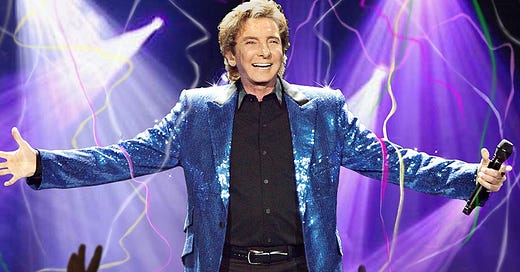



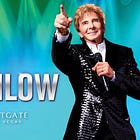

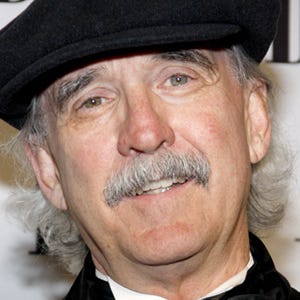


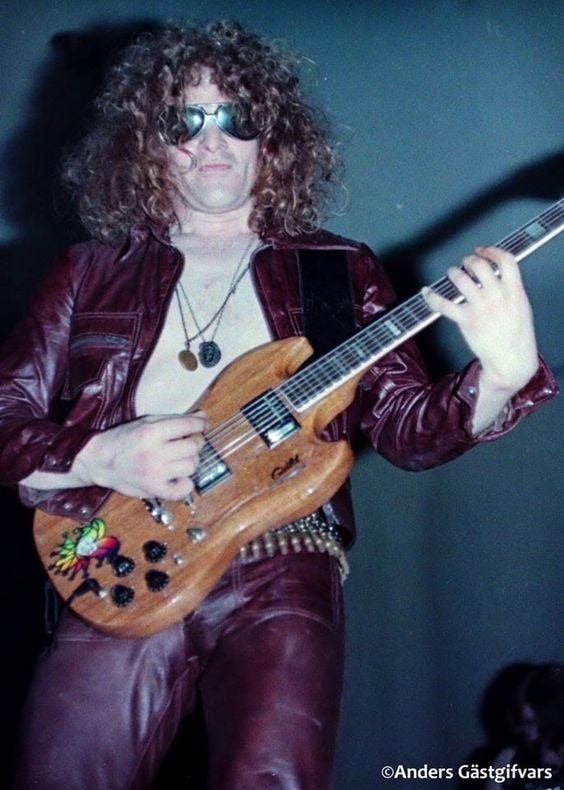

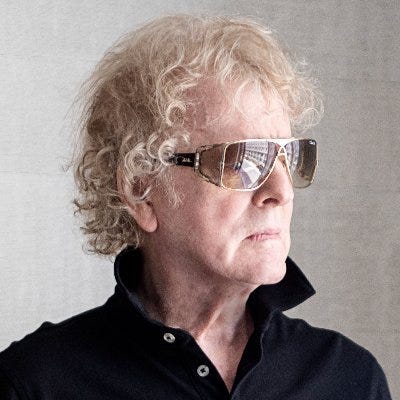
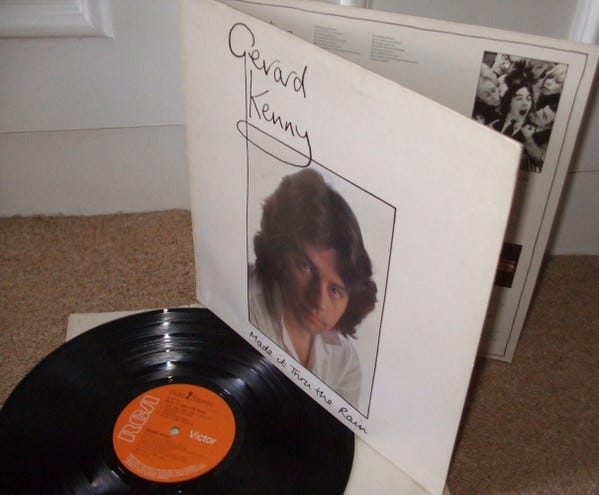
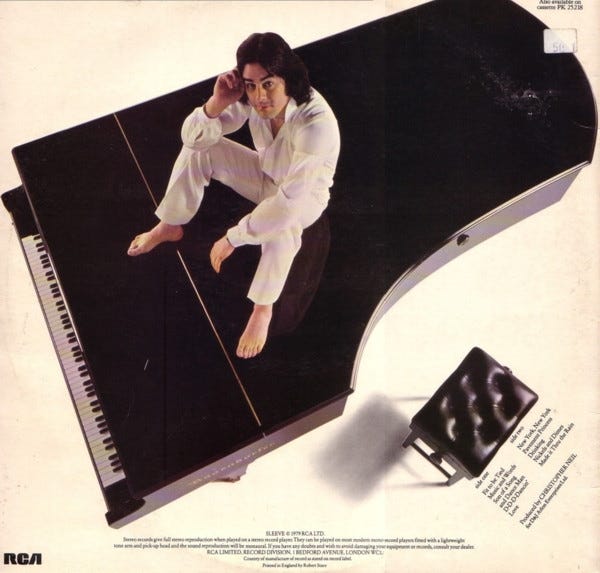

My mom loved Manilow. As a kid and young adult, I thought he was so lame. Now that she's been gone nearly 20 years, his music has a certain comforting nostalgic quality to it. I'm still probably never going to put it on myself, but if it comes on the radio or someone else is playing it, I'm not complaining anymore.
Thanks for the shout out, Brad! Kilgore is a fascinating place.